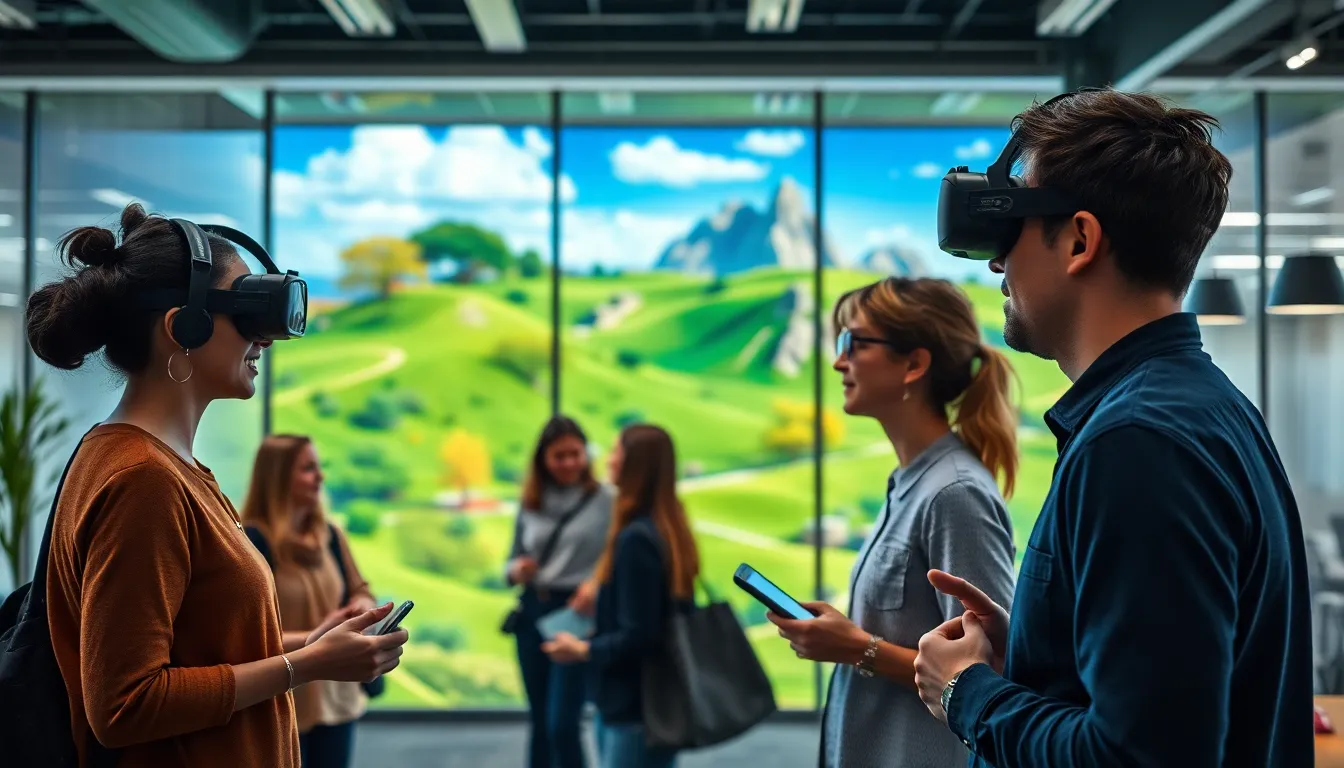In a world where reality often feels like a blurry line between the virtual and the tangible, the concept of hybrid reality is shaking things up. Imagine a future where digital elements seamlessly blend with the real world, creating experiences that are as entertaining as they are transformative. Whether it’s a virtual meeting with holographic coworkers or a stroll through a digital art gallery that exists in your living room, hybrid reality is set to redefine how we interact with our surroundings.
As technology evolves at lightning speed, predicting the future of hybrid reality becomes not just a fun exercise but a necessity. Businesses, educators, and gamers alike are already gearing up for this new frontier. So buckle up, because the hybrid reality forecast is not just a glimpse into tomorrow—it’s a ticket to a whole new dimension of possibilities.
Table of Contents
ToggleUnderstanding Hybrid Reality Forecast
Hybrid reality combines digital elements with the physical environment, transforming experiences across various sectors. Its applications span numerous fields, including business, education, and entertainment. In virtual meetings, for instance, employees can interact with holographic coworkers, enhancing collaboration. Educational institutions may leverage this technology to create immersive learning environments, allowing students to engage with complex concepts interactively.
Real estate showcases another prominent application. Virtual property tours with integrated augmented features enable potential buyers to visualize spaces more effectively. As hybrid reality evolves, art galleries increasingly adopt digital components, providing new ways for viewers to experience artwork in their homes.
Forecasts for hybrid reality emphasize rapid integration into daily life. Gartner projects that by 2025, 30% of businesses will use hybrid reality for significant projects. Such statistics underscore the need for adaptation in both workforce skills and technological capabilities.
Investments from technology firms further reinforce this trend. Facebook, Microsoft, and Apple are prioritizing development in augmented and virtual reality platforms. Collaborations are emerging between companies to enhance user interfaces and improve accessibility.
Hybrid reality’s potential reaches beyond mere entertainment on multiple levels. It fosters connections between users regardless of physical distance, transforming how people socialize. Retail experiences become immersive, allowing consumers to try products virtually before purchase.
As the technology matures, guidelines will emerge to navigate ethical considerations. Data privacy and user consent will require focus, ensuring responsible usage. Overall, a hybrid reality forecast presents significant opportunities for innovation and engagement across various domains.
Key Components of Hybrid Reality

Hybrid reality combines digital and physical elements to create innovative experiences. Two main components significantly contribute to its framework: augmented reality and virtual reality.
Augmented Reality Integration
Augmented reality (AR) overlays digital content on the real world, enhancing interactions. This integration allows users to interact with virtual objects while remaining aware of their physical surroundings. Applications span various fields including business, where AR can streamline workflow processes and improve communication. For instance, companies can utilize AR for remote assistance, enabling experts to guide on-site workers using live video and 3D models. In education, AR enriches lessons through interactive elements, making subjects engage more dynamically. Retail also benefits from AR, providing customers with virtual try-ons that improve purchase confidence. By 2025, it’s estimated that 30% of educational institutions will incorporate AR into their curricula, further demonstrating its potential.
Virtual Reality Elements
Virtual reality (VR) immerses users in completely digital environments, creating unique experiences. This technology transports individuals to places where they interact with 3D simulations, enhancing realism. In entertainment, users can explore virtual worlds or participate in simulated adventures, fostering deeper engagement. Corporate training programs increasingly adopt VR, offering employees realistic scenarios to practice skills without real-world consequences. Additionally, VR plays a crucial role in real estate. Prospective buyers can take immersive virtual tours, gaining better insights into properties. Significant technology investments in VR by companies like Facebook and Microsoft drive innovation in this area, ensuring a bright future for hybrid reality initiatives.
Applications of Hybrid Reality Forecast
Hybrid reality is quickly finding applications across various sectors, enhancing experiences and interactions.
Industry Uses
Manufacturing companies utilize hybrid reality to streamline operations. These businesses implement AR for maintenance, enabling technicians to visualize issues and access real-time data. In healthcare, AR aids surgeons during procedures with digital overlays that improve precision. Retail environments leverage hybrid reality by allowing customers to visualize products in their spaces before purchasing. A forecast predicts that by 2025, 30% of manufacturers will adopt hybrid reality, significantly improving efficiency and reducing costs. Transportation and logistics firms also integrate hybrid reality for route optimization and fleet management, aiding in better resource allocation.
Consumer Engagement
Consumers engage with brands through hybrid reality experiences that blur digital and physical boundaries. For example, virtual try-ons allow users to see how outfits or accessories appear on them without stepping into a fitting room. Brands create immersive ad campaigns that attract consumers’ attention and enhance brand loyalty. A notable development involves interactive content that lets users participate in experiences, resulting in higher retention rates. By 2025, it’s expected that 40% of consumer-facing companies will adopt these techniques to foster deeper connections with their audiences. Enhanced engagement through hybrid reality results in more personalized experiences, ultimately driving sales and customer satisfaction.
Future Trends in Hybrid Reality
Hybrid reality continues to evolve rapidly, influenced by advancements in technology and societal shifts. As interactions blend physical and digital worlds, several noteworthy trends emerge.
Technological Advancements
Innovations in technology drive the progress of hybrid reality. Next-generation AR and VR technologies enhance user experiences across various sectors. Companies invest heavily in immersive solutions to improve workflows, learning, and entertainment. Major players like Facebook, Microsoft, and Apple commit substantial resources, ensuring ongoing development. By 2025, projections indicate that 30% of educational institutions will integrate AR into their curricula. Virtual meetings featuring holographic coworkers may soon become commonplace, revolutionizing collaboration. Enhanced mobile devices and wearable tech increase accessibility for users. Upsurge in 5G connectivity supports seamless integration of hybrid experiences, making real-time data visualization straightforward.
Societal Impact
Changes in societal norms deriving from hybrid reality initiatives impact everyday life. Enhanced digital experiences redefine how individuals interact with brands and each other. For instance, virtual try-ons allow consumers to visualize products before purchasing, increasing satisfaction. Collaboration between businesses and educational institutions promotes the adoption of innovative solutions. By 2025, it’s expected that 40% of consumer-facing companies will utilize hybrid reality to deepen customer engagement. Accessibility of these technologies fosters inclusivity among diverse populations. Ethical concerns, particularly regarding data privacy and user consent, demand consideration, paving the way for responsible advancements. Overall, hybrid reality shapes a future where physical and digital interactions strengthen communities.
The future of hybrid reality holds immense potential to reshape how society interacts with technology and each other. As businesses and educational institutions embrace these advancements, the integration of AR and VR will foster more engaging and productive environments. With significant investments driving innovation, the forecast indicates a rapid adoption across various sectors.
Ethical considerations will play a crucial role in ensuring that these technologies enhance user experiences while safeguarding privacy. As hybrid reality continues to evolve, it will undoubtedly create new opportunities for connection and collaboration, paving the way for a more immersive and inclusive world.






